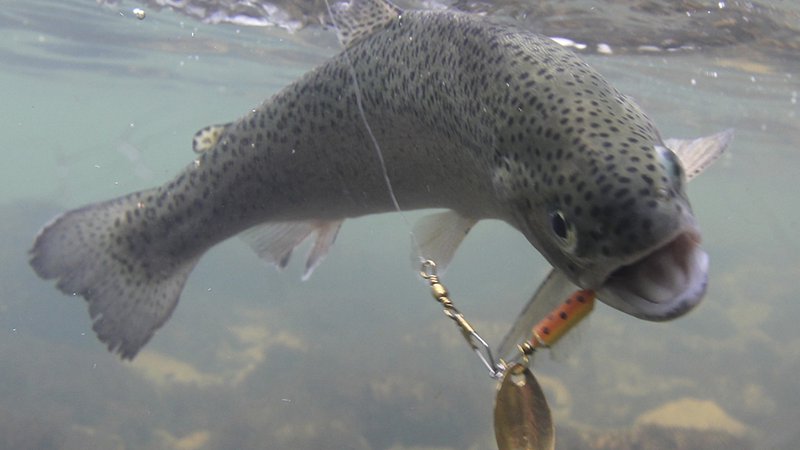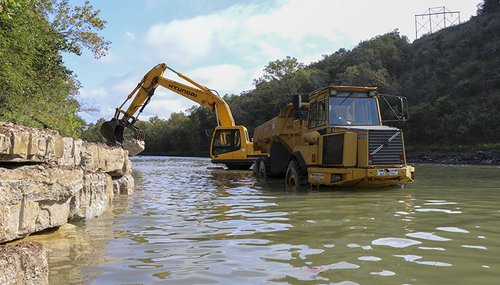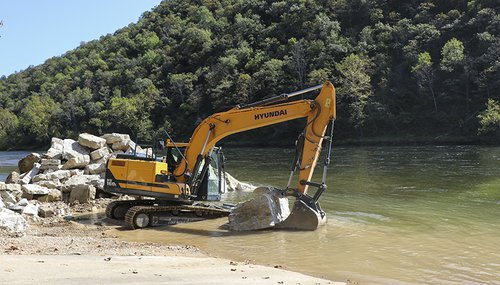Beaver Tailwater project partnership highlighted at Trout Unlimited national conference
ON 10-09-2019

Oct. 9, 2019
Randy Zellers
Assistant Chief of Communications
ROGERS — Dozens of conservationists and anglers gathered at Dam Site Park Access below Beaver Dam last Thursday to learn more about how the AGFC is throwing stones to create better water quality and fish habitat on the Beaver Tailwater.
The tour was part of the organization’s annual conference, which was held this year in Arkansas.
“We’re extremely proud of the fact that our project was chosen to be featured in the tour and even more proud that the state’s fisheries and trout anglers were convincing enough to hold such a conference,” said Ben Batten, AGFC chief of fisheries.

The Beaver Tailwater, a short drive from downtown Rogers, may not receive the same national attention as the North Fork, White and Little Red rivers in Arkansas, but that does not mean it receives short shrift when it comes to management activities from the AGFC, U.S. Fish and Wildlife Service and other partners.
“The Beaver Tailwater actually receives one of the highest stocking rates per river mile than other trout fisheries in Arkansas,” said Christy Graham, AGFC trout management supervisor. “It flies under the radar, but it is well known among local anglers and we put just as much emphasis on access and habitat quality here as we do with other trout fisheries in the state.”
The challenge for this particular fishery is the extreme fluctuation in water levels and current when excessive rain fills the White River watershed.
“There are times when the system fills and they have to release water through emergency measures,” Graham said. “That happens on other lakes like Bull Shoals as well, but it happens much more frequently at Beaver.”
Jared Trammell, chief park ranger over natural resources at the Corps of Engineers Beaver Lake Office, said, “Since 2008, we’ve had to open the spillway gates just about every two years. The last decade’s water cycles have impacted the fishery quite a bit.”
According to Michael Wingo, vice-chair of the Arkansas Council for Trout Unlimited, the extreme flow created during high water years wreaked havoc on the trout population as well as the habitat between Beaver Dam and Table Rock Lake.
“We would see flows jump from 300 cubic feet per second to more than 92,000 cubic feet per second,” Wingo said. “Water that would normally remain in the main channel would be 15 feet high in the trees on the surrounding bank.”
Graham says these high flow events scoured massive amounts of sediment from the banks of the tailwater area, which creates many issues with water quality as well as fish production.

“The erosion of the streambank and resulting sediment load is a serious concern for the fishery,” Graham said. “It impacts many things such as water temperature and dissolved oxygen, and it also can impact trout reproduction which has always been a critical issue in our tailwaters. Even when egg boxes were placed by Trout Unlimited in Beaver Tailwater, the heavy sediment load from stream bank erosion would settle to the bottom and smother the eggs before they could hatch. The high flows, especially in spring are one of the main obstacles to reproductive success in this tailwater.”
Many projects have taken place to improve the aquatic habitat along this stretch of river between Beaver Lake in Arkansas and Table Rock Lake in Missouri. Tim Burnley, AGFC stream habitat supervisor, says the Beaver Tailwater saw one of the first trout habitat projects where a state agency and the federal government came together in the early 1990s.
“They placed log cribs in the channel to offer current breaks and habitat, and we’re still working around some of those same cribs today,” Burnley said. “We’ve revisited the tailwater many times, improving portions of the streambank with rock walls and vanes that help direct flow to reduce erosion, but we still have much work to do.”
The current project, fortifying a quarter-mile stretch of bank with stacked stone, has been in the planning stage for the last 6 years. The rock walls will take the brunt of the current’s force, minimizing erosion of the soil and gravel in the streambed. Crews have been hard at work since September 16, and plan to be wrapped up by winter, but the planning process was a much more time-consuming an arduous task.
In addition to logistics, budgets and acquiring materials, many permits must be secured before undertaking such work on a river and especially locations managed by the U.S. Army Corps of Engineers.
“About 320,000 people rely on Beaver Lake as a water source,” Burnley said. “It’s also a source of hydroelectric power and a major component in the White River chain of lakes that include Table Rock, Bull Shoals, Norfork and even the White River flowing out to meet the Arkansas. The Corps does an excellent job of handling all these tasks, but that means being very thorough about any new management efforts that could impact one of the many variables at play.”
During that timeframe, many partners were assembled to gather materials and store them for the project.
“Trout Unlimited worked with Riverview Resort, who was willing to store the rock on part of their property, and even paid some rent to the resort when high water delayed the project beyond its original commitment,” Burnley said. “It may not seem like much, but hauling this size rock is extremely time-consuming and expensive. Having the rock ready to go close to the project has made a huge difference in our ability to work quickly while flows are lower.”
Trout Unlimited stepped up again when it looked like the project would be put on hold for archaeological purposes.
“The archaeologist’s report on clearing any significant historical records of Native American activity was challenged with only a few weeks left before the project’s final review,” Burnley said. “But our partners at Trout Unlimited found a licensed and approved archaeologist to come through with a new report.on short notice.”
Wingo says the Northwest Arkansas Chapter of TU was fortunate to find a qualified archaeologist who saw the importance of the project and was willing to take on the task with very little notice.
“I reached out to Tim Klinger at Historic Preservation Associates, who has an office in Fayetteville,” Wingo said. “Not only was he willing to take on the job with such a fast turnaround, but he donated $10,000 of his $12,500 fee to the project. Trout Unlimited came up with the remainder.”
The Corps pitched in with storage of the heavy equipment needed for the work on site and also helped with the management of water flow to give workers enough time each morning to make headway into the project.
“This is all being done on an active campsite, so we are working with the AGFC to manage any sort of disturbance to campers and let them have time to enjoy the water despite the ongoing project. We also are still trying to lower Beaver Lake to conservation pool, so we do have to have some flow,” Trammell said. “But we’ve been able to set aside a large block of time in the mornings for the work to take place while we still meet our projected pool level.”
Burnley says the project is a testament to the many benefits partners can have in conservation.
“Everyone brought something to the table and we’re able to do something that is making a difference,” Burnley said. “The cooperation we’ve seen here is nothing short of amazing, and the results will be evident for decades to come.”
Recent News
Subscribe to Our Weekly Newsletter E-mails
Don’t miss another issue. Sign up now to receive the AGFC Wildlife Weekly Newsletter in your mailbox every Wednesday afternoon (Waterfowl Reports are published weekly during waterfowl season and periodically outside the season). Fishing Reports arrive on Thursdays. Fill in the following fields and hit submit. Thanks, and welcome!


